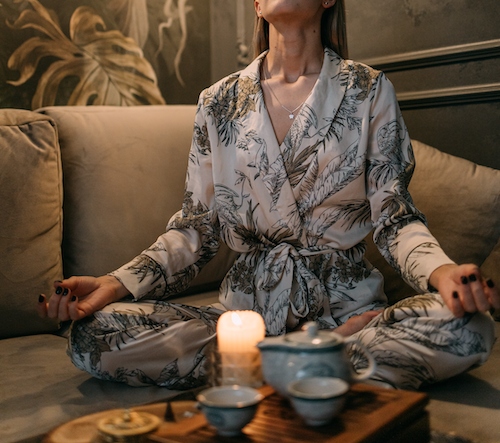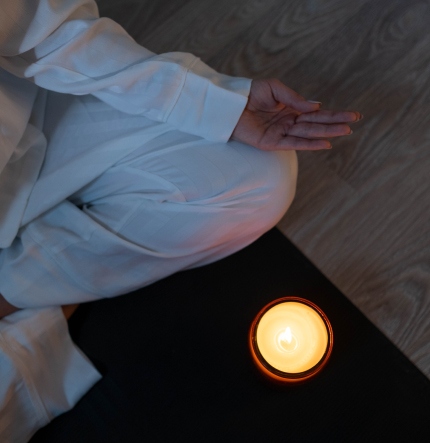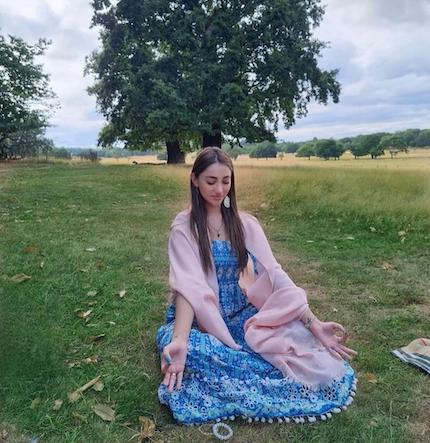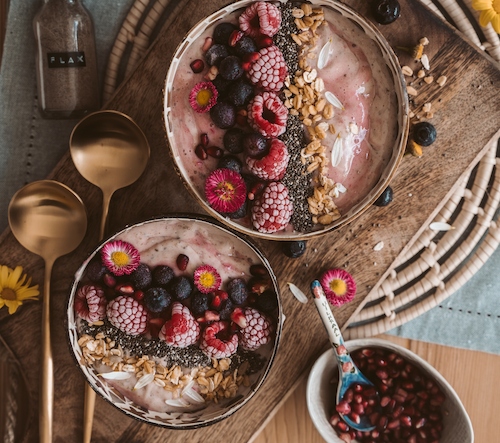
28 September 2022
My Meditation Routine and Rituals: Candle Gazing
There are many ways to approach meditating, but one of my preferred practices is candle gazing meditation. I find that by focusing my attention on a single object, I am able to drop in quicker and deeper into the meditation.
Meditation is an ancient practice that allows us to pull away from our busy lives and focus our attention inwards. It’s a chance to check in, take stock and ground ourselves in the here and now.
I am so glad that more and more people are adopting this powerful practice as part of their regular routines. Research suggests that meditation can not only calm our minds, reduce stress and improve our mental well-being but also enhance our cognitive function, improve our sleep and, in some cases, even make us live longer.
What is candle gazing?
Also known as trataka in Sanskrit, candle gazing is a form of yogic purification and a tantric method of meditation. The word itself means to look or gaze. The idea behind candle gazing is that by giving a single object all of your attention, you can no longer give attention to all the things that worry you in your external world. Instead, you empty your mind and look inwards.
So, why do we choose a candle to focus our attention?
Ayurveda, traditional Indian medicine, teaches us that the universe is composed of five elements: Akasha (space or ether), Vayu (air), Jala (water), Prithvi (earth) and Teja or Angi (fire). These five elements are condensed into three constitutional types, called doshas, which are Vata (space and air), Pitta (fire and water) and Kapha (water and earth). Everyone carries different proportions of all three doshas, which determines our physical and mental states.
Fire is the element that helps focus and cognition and makes up part of our Pitta dosha, which governs transformation. By using the candle’s flame to focus our attention during meditation, we are refining our Tejas to enhance our focus and ability to process and gain mental clarity.


What are the benefits of candle gazing?
While I have touched on some of the benefits of this type of meditation already, such as improved mental health, sleep and cognition, there’s the added benefit of deepening your spiritual practice.
Fire is transformative. When you gaze at a flame it is constantly flickering and dancing, forever changing its form. It changes things from one to the other by melting, burning or heating. It can either burn hot and quickly destroy everything in its path or slowly smoulder deep in the Earth’s core or internalised body.
By gazing at the candle in a meditative state, the flame transforms us. It takes us beyond the material world and unlocks our third eye chakra in the centre of our forehead. This chakra is all about spirituality and perception, aiding in connecting with our intuition. When we tap in, we can hear what our intuition is telling us, which is where candle gazing can be truly transformative.
How to candle gaze
The beauty of candle gazing is in its simplicity. Anyone can do it by following some easy steps:
- Find a suitable time of day where you are unlikely to be disturbed – this could be first thing in the morning or just before going to bed
- Find a dark or dimly lit space you feel safe and comfortable in
- Place your candle at eye level on a stable surface before lighting
- Take a few deep cleansing breaths to settle in and focus on your intention
- Gaze at the candle’s flame and follow its movements
- Observe your thoughts as they come up without judgement
- Try to blink as little as possible, and don’t worry if you feel tears beginning to well, let them naturally fall
- Focus on your eyes merging into one to invoke the intuitive third eye chakra
- Finish by thanking yourself and taking a moment of gratitude
I’d recommend starting with shorter meditations (around 3-5 minutes) and practising regularly to build it into a daily ritual. Once you feel ready and comfortable, you can extend the length of your meditation if you feel called to do so.
My personal meditation routine
Candle gazing is a formative part of my spiritual practice, which I like to incorporate into my morning routine when I first wake up or as part of my evening ritual 30 minutes before going to bed. Practising at these times is optimal for programming the subconscious mind as it can set you up for a positive day ahead or aid a restful night’s sleep.
I start by cleansing my space by either burning palo santo or sometimes sage before finding a comfortable seated position and settling in. I first start with a mini grounding visualisation practice where I imagine roots growing from my tailbone into the core of the Earth. Once I feel grounded, I light the candle and focus on the flame for my candle gazing meditation. I close my practice by visualising a bright white light surrounding me for protection.
If I want to call on the universe to bring something in particular into my life, I will add some visualisations to aid my manifestations. This is where tapping into your intuition during the candle gazing meditation is so powerful as you can unlock your hearts’ true desires. Once you have that clarity, you can visualise those desires, whether opening a new business, good health or finding your soulmate. End by reciting affirmations in the present tense as though you already have your desires, such as: “I am a successful business owner” to put them out into the universe.
All forms of meditation are beneficial, but I believe candle gazing is a great one to start out with if you’re new to the practice. Having something to lock your gaze on helps train your mind to focus, and it only takes 5 minutes out of your day.








